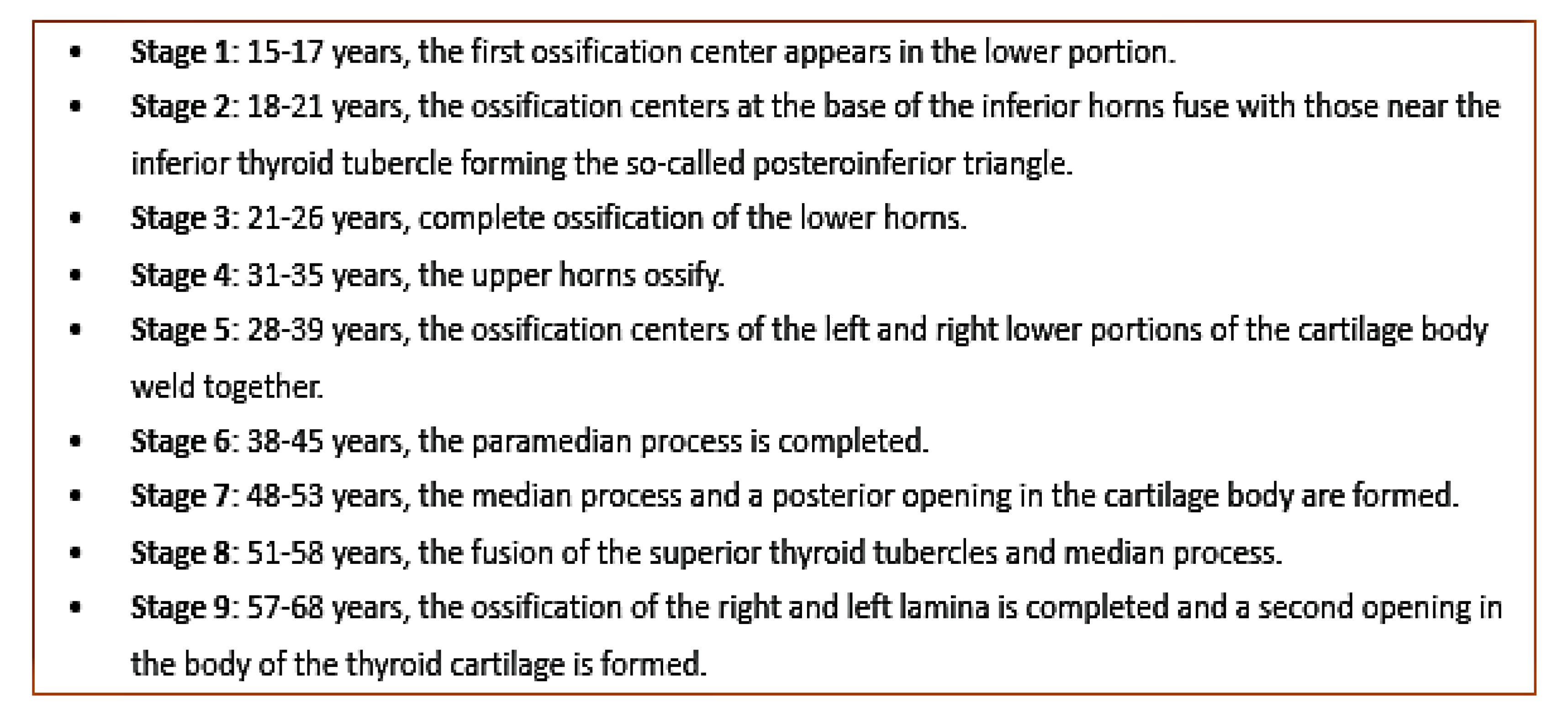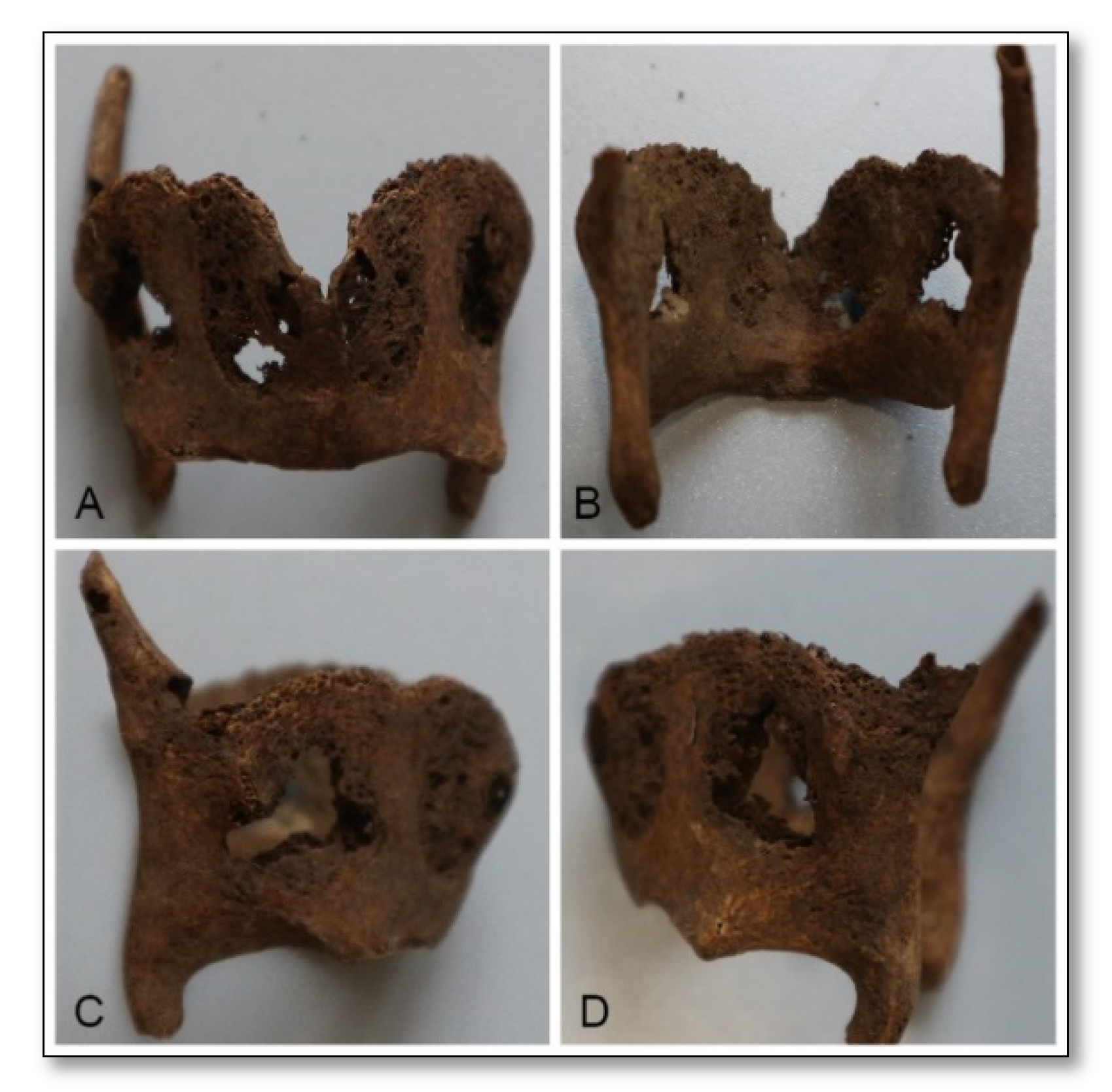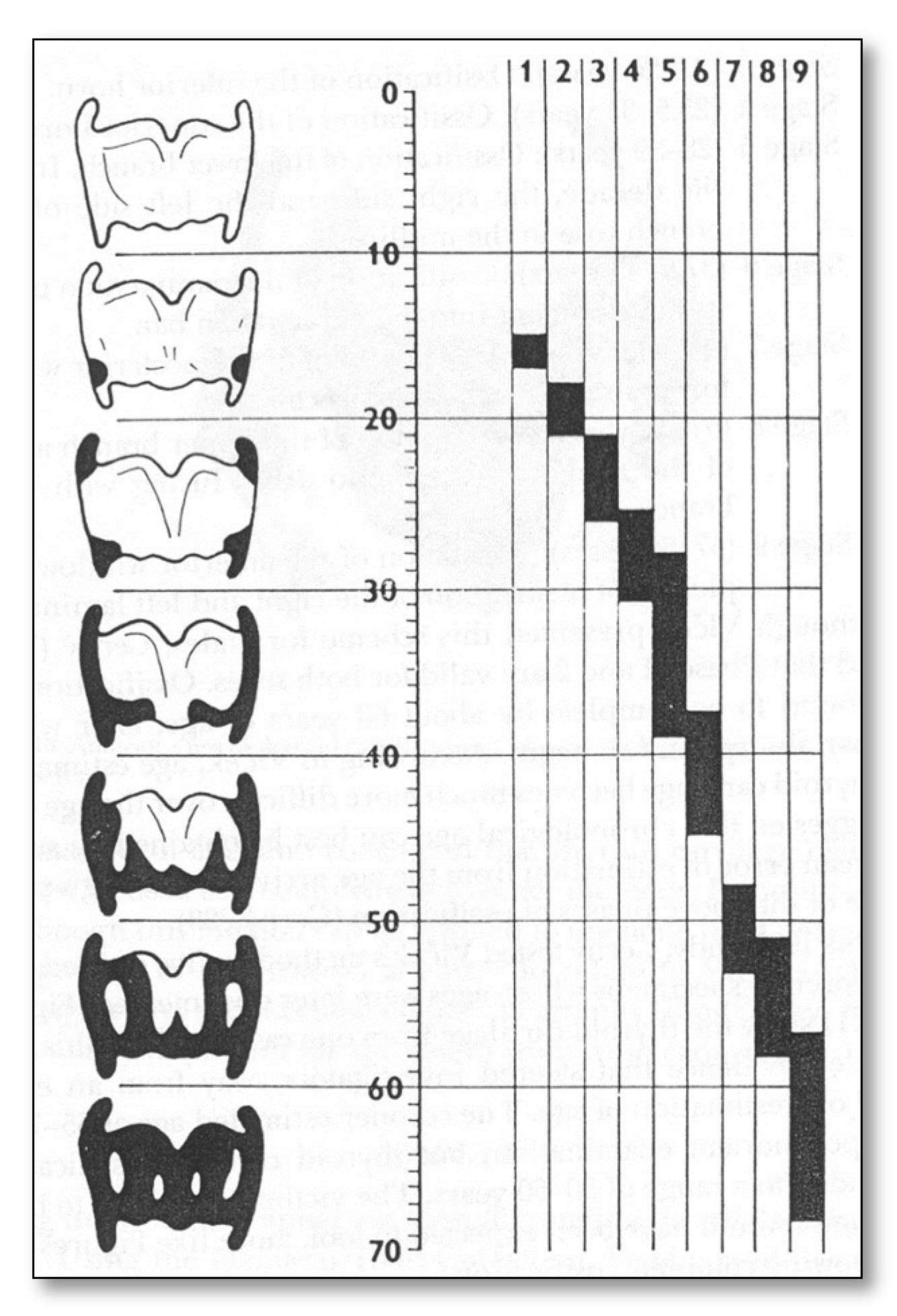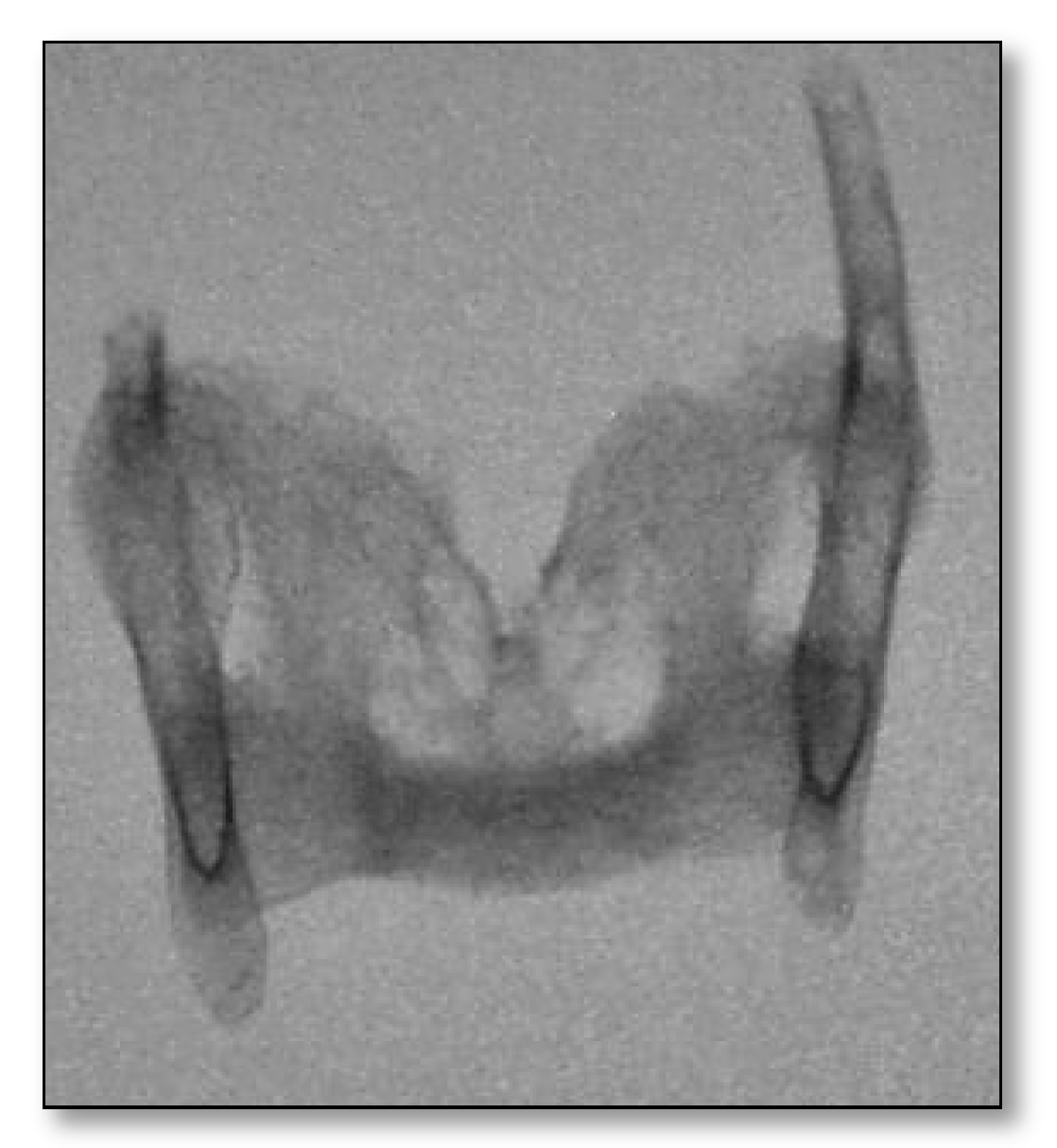Fully Ossified Thyroid Cartilage Found among the Skeletal Remains of A 21-Year-Old Slavic Soldier: Interpretation of a Case
Abstract
:1. Introduction
2. Case Report
3. Discussion
4. Conclusions
5. Impact Statement
Author Contributions
Funding
Institutional Review Board Statement
Informed Consent Statement
Data Availability Statement
Conflicts of Interest
References
- Balboni, G.C.; Anastasi, G.; Capitani, S.; Carnazza, M.L.; Cinti, S.; De Caro, R.; Donato, R.F.; Ferrario, V.F.; Fonzi, L.; Franzi, A.T.; et al. Anatomia umana, 3rd ed.; Edi Ermes: Milano, Italy, 2000; Volume 2, p. 295. [Google Scholar]
- Travan, L.; Favaro, F.; Rossitti, P.; Iona, P. Dall’Anatomia al Movimento; Paletto Editore: Milano, Italy, 2004; p. 333. [Google Scholar]
- White, T.D.; Black, M.T.; Folkens, P.A. Folkens, Human Osteology, 3rd ed.; Academic Press: Tokyo, Japan, 2011; p. 384. [Google Scholar]
- Chiarugi, G.; Bucciante, L. Istituzioni di Anatomia Dell’uomo; Società Editrice Dr. Vallardi: Milano, Italy, 1986. [Google Scholar]
- Vlcek, E. Anwendung von zwei methoden the forensischen medizen zur altersbestimmung in der palaoanthropologie. Anthr. Kozl. 1974, 18, 199–209. [Google Scholar]
- Vlcek, E. Odhad stari jedince stanoveny na kosternim materialu podle stupne osifikace chrupavky stitne (Estimation of age frome skeletal material based on de degree of thyroid cartilage ossification). Soud. Lek. 1980, 25, 45. [Google Scholar]
- Cenry, M. Our Experience with Estimation of an Individual’s Age from Skeletal Remains of the Degree of Tyroid Cartilage Ossification; Department of Mathematical Analysis and Applications of Mathematics, Faculty of Science, Palacký University: Olomouc, Czech Republic, 1983; Volume 3, pp. 121–144. [Google Scholar]
- Francesco, I.; Dell’Erba, A. Determinazione Dell’età dei Resti Scheletrici; Essebiemme: Bari, Italy, 2000; Volume 2, pp. 95–96. [Google Scholar]
- Macmillan, T.S. Britain, Mihailovic, and the Chetniks, 1941–1942. The Special Operations Executive (SOE), the Yugoslavs and European Resistance; Elsevier: Amsterdam, The Netherlands, 1998; pp. 17–30. [Google Scholar]
- Powers, N. Human Osteology Method Statement. Museum of London, 2012. Available online: https://www.museumoflondon.org.uk/application/files/4814/5633/5269/osteologymethod-statement-revised-2012.pdf (accessed on 13 September 2019).
- Bass, M.W. Human Osteology; Cap 17; Missouri Archaeological Society: Columbia, MO, USA, 1995. [Google Scholar]
- Mckern, T.W.; Stewart, T.D. Skeletal Age Changes in Young American Males; uartermaster Research and Development Command Technical Report EP-45; QNational Government Publication: Natick, MA, USA, 1957. [Google Scholar]
- Meindl, R.S.; Lovejoy, C.O. Ectocranial suture closure: A revised method for the determination of skeletal age at death based on the lateral-anterior sutures. Am. J. Phys. Anthropol. 1985, 68, 57–66. [Google Scholar] [CrossRef] [PubMed]
- Lovejoy, C.O. Dental Wear in Libben Population: Its Functional Pattern and Role in the Determination of Adult Skeletal Age at Death. Am. J. Phys. Anthropol. 1985, 68, 47–56. [Google Scholar] [CrossRef] [PubMed]
- Brooks, S.; Suchey, J.M. Skeletal age determination based on the os pubis: A comparison of the Acsádi-Nemeskéri and Suchey-Brooks methods. Hum. Evol. 1990, 5, 227–338. [Google Scholar] [CrossRef]
- Trotter, M.; Gleser, G.C. A reevaluation of stature estimation based on measurements of stature taken during life and long bones after death. Am. J. Phys. Anthropol. 1958, 16, 79–123. [Google Scholar] [CrossRef] [PubMed]
- Osso, M.R.J. Laboratory Histopathology (7.2-10); Woods, A.E., Ellis, R.C., Eds.; Churchill Livingstone: New York, NY, USA, 1994. [Google Scholar]
- Jurik, A. Ossification and calcification of the laryngeal skeleton. Acta Radiol. Diagn. 1984, 25, 17–22. [Google Scholar] [CrossRef] [PubMed]
- Kirsch, T.; Claassen, H. Matrix vesicles mediate mineralization of human thyroid cartilage. Calf. Tissue Int. 2000, 66, 292–297. [Google Scholar] [CrossRef] [PubMed]
- Strek, P.; Nowogrodzka-Zagorska, M.; Skawina, A.; Olszewski, E. Ossification of human thyroid cartilage. Scanning electron microscopic study. Folia Morphol. 1993, 52, 47–56. [Google Scholar]
- Jaiprabhu, S.P.; Prabhu, K. Ossified Thyroid Cartilage: A Tool for Determining Age and Sex of an Individual. Med. Sci. 2015, 4, 190. [Google Scholar] [CrossRef]
- Hately, B.; Evison, G.; Samuel, E. The pattern of ossification in the laryngeal cartilages: A radiological study. Br. J. Radiol. 1965, 38, 585–591. [Google Scholar] [CrossRef] [PubMed]
- Vogl, T.J.; Balzer, J.; Mack, M.; Steger, W. Differential Diagnosis in Head and Neck Imaging; Thieme: New York, NY, USA, 1999; pp. 315–317. [Google Scholar]
- Velentzas, C.; Orepoulos, D.G. Soft tissue calcification in chronic renal failure. Int. J. Artif. Organs 1979, 2, 6–8. [Google Scholar] [PubMed]
- Alawi, F.; Freedman, P.D. Metastatic calcification of the nasal septum presenting as an intraoral mass: A case report with a review of the literature. Oral Surg. Oral Med. Oral Pathol. Oral Radiol. Endodontol. 2001, 91, 693–699. [Google Scholar] [CrossRef] [PubMed]
- Potts, J.T., Jr. Malattie della ghiandola paratiroidea e altri disturbi iper e ipocalcemici. In Principi di Medicina interna di Harrison, 14th ed.; Kasper, D.L., Fauci, A.S., Longo, D.L., Hauser, S.L., Jameson, J.L., Loscalz, J., Eds.; McGraw Hill: New York, NY, USA, 1998; Volume 2, pp. 2227–2236. [Google Scholar]
- Longin, R. New Method of Collagen Extraction for Radiocarbon Dating. Nature 1971, 230, 241–242. [Google Scholar] [CrossRef] [PubMed]
- White, T.D.; Folkens, P.A. The Human Bone Manual; Palgrave Macmillan: London, UK, 2005; Volume 4, pp. 31–48. [Google Scholar]





Publisher’s Note: MDPI stays neutral with regard to jurisdictional claims in published maps and institutional affiliations. |
© 2021 by the authors. Licensee MDPI, Basel, Switzerland. This article is an open access article distributed under the terms and conditions of the Creative Commons Attribution (CC BY) license (https://creativecommons.org/licenses/by/4.0/).
Share and Cite
Leggio, A.; Introna, F. Fully Ossified Thyroid Cartilage Found among the Skeletal Remains of A 21-Year-Old Slavic Soldier: Interpretation of a Case. Forensic Sci. 2021, 1, 213-219. https://doi.org/10.3390/forensicsci1030019
Leggio A, Introna F. Fully Ossified Thyroid Cartilage Found among the Skeletal Remains of A 21-Year-Old Slavic Soldier: Interpretation of a Case. Forensic Sciences. 2021; 1(3):213-219. https://doi.org/10.3390/forensicsci1030019
Chicago/Turabian StyleLeggio, Alessia, and Francesco Introna. 2021. "Fully Ossified Thyroid Cartilage Found among the Skeletal Remains of A 21-Year-Old Slavic Soldier: Interpretation of a Case" Forensic Sciences 1, no. 3: 213-219. https://doi.org/10.3390/forensicsci1030019
APA StyleLeggio, A., & Introna, F. (2021). Fully Ossified Thyroid Cartilage Found among the Skeletal Remains of A 21-Year-Old Slavic Soldier: Interpretation of a Case. Forensic Sciences, 1(3), 213-219. https://doi.org/10.3390/forensicsci1030019






